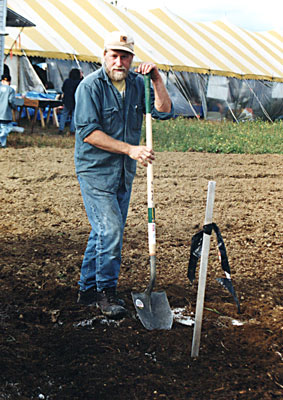 |
| Mark Fulford demonstrated how to prepare the soil for fruit tree planting at the Common Ground Fair. This area was later seeded to Geneva winter wheat, which will be harvested next July and milled into a flour, then used in a baked product for the 2000 Common Ground Fair; and Mammoth red clover, which will blanket the plot after the wheat is harvested next summer. Fulford explained that winter wheat, sown between mid-September and mid-October, competes better with spring weeds than spring wheat does. English photo. |
The most exciting thing about the Common Ground Fair this year was not the smooth flow of traffic into and out of the site. That was the second most exciting thing; the MOFGA staff, volunteers and the Waldo County Sheriff’s Department did a superb job of managing traffic so that no one waited to park.
The most exciting thing for me was the program of speakers and demonstrators in the Agricultural Demonstrations Area, thanks in large part to Area Coordinators CR Lawn, Jack Kertesz and Joan Sheldon. And the most exciting part about some of these demonstrations was their permanence. Living history museums, such as Norlands and Sturbridge, are fine, but at Unity MOFGA is creating a living non-history non-museum. The transformation from 1998, when the site was first opened, to 1999, with regard to the greening of the site, has been remarkable.
Demonstration plots of green manures, cover crops and herbs have been planted. A lush growth of clover and grass covers much of the site. Dozens of trees have been planted, including American chestnuts. Now an orchard is in the works, as well.
Mark Fulford, one of Maine’s premier horticulturists, gave an excellent demonstration of orchard site preparation. “You don’t have to spend half an hour shaking sod out” of the earth in the spring when you’re planting trees, and later “wonder why the tree is in suspended animation for two years,” said Mark. Instead, he recommended taking time in the fall to cover an area about 5 feet in diameter with two to three shovels full of lime (if your soil needs it; most do) and a layer of compost. Rock powders can be added if they are needed. The lime, compost and minerals can be added in layers or mixed together before they’re spread, then put on the ground, right over the sod.
Next the area is covered with cardboard, and the cardboard is held in place with wood chips – a wagon full of chips,” according to Mark’s recipe. Thus, “On turf, you don’t need to dig the whole field” to prepare an orchard site, Mark explained.
Mark reminded prospective planters not to let the compost dry out, because that interferes with its biological activity. During the fall, winter and early spring, the biological activity in the compost and from the soil life below, including earthworms, will make nutrients available for the fruit tree, which will be planted through these organic layers during the last week of April. “Keep the nitrogen low and the mineral sources high,” Mark recommended. “The rotting sod will provide enough nitrogen,” and the cardboard, compost and mulch will promote the rotting of the sod.
“Instead of doing the Roundup number, do the mulch-up number,” said Mark. Good advice, especially since a recent piece in the journal Cancer has given preliminary data suggesting that the glyphosate herbicides, such as Roundup, may cause cancer.
The orchard to be planted at Unity will provide not only demonstrations but experimental data as well. Fruit trees will be planted in the fall and in the spring. Spring is the commonly recommended time for Maine, but MOFGA’s orchard committee wants to test the possibility of fall planting. Some trees will be planted in plots prepared as Mark described above, while others will be planted without the compost/mulch/mineral additions.
With its Unity site in an active stage of development now, MOFGA is rounding up some great agricultural talent. Look forward to more and more information coming out of Unity that should help growers increase yields and profits and reduce pesticide use.
– Jean English
